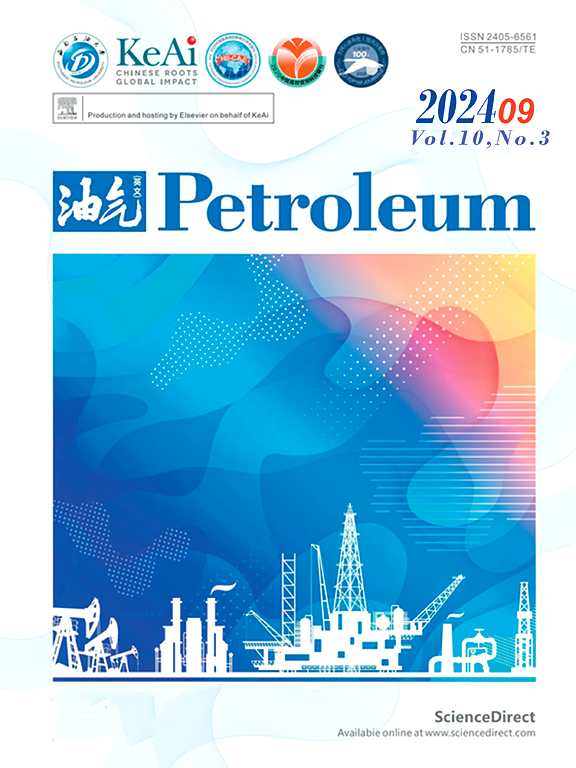A review of the critical conditions required for effective hole cleaning while horizontal drilling
IF 4.2
Q2 ENERGY & FUELS
引用次数: 0
Abstract
Horizontal drilling has become increasingly prevalent in the oil and gas industry due to its potential for enhanced reservoir recovery and reduced environmental impact. However, effective hole cleaning remains a critical challenge in horizontal drilling operations directly impacting drilling efficiency and overall project economics. This review paper aims to comprehensively analyze the critical conditions required for effective hole cleaning in horizontal drilling operations. It investigates the mechanics of cuttings transport within horizontal wells, analyzing the forces at play and various flow patterns. It discusses different methodologies, including empirical correlations, experimental studies, machine learning models, and modeling techniques, used to assess hole cleaning efficiency. Drawing from literature, industry guidelines, and case studies, the study identifies key factors such as fluid properties, wellbore geometry, and drilling parameters influencing hole cleaning efficiency. Challenges such as low annular velocity and complex lithology are highlighted, alongside technological downhole tools innovations. By synthesizing these findings, the paper underscores the importance of addressing these challenges to optimize drilling performance. Serving as a valuable resource for engineers and researchers, it provides insights into optimization techniques and innovations to enhance drilling efficiency in horizontal wellbores, thus facilitating improved operational outcomes.
回顾了水平钻井时有效清洗井眼所需的关键条件
由于具有提高油藏采收率和减少环境影响的潜力,水平钻井在油气行业中变得越来越普遍。然而,在水平钻井作业中,有效的井眼清洁仍然是一个关键的挑战,直接影响钻井效率和整个项目的经济性。本文旨在全面分析水平钻井作业中有效清洗井眼所需的关键条件。它研究了水平井中岩屑运移的机理,分析了起作用的力和各种流动模式。它讨论了不同的方法,包括经验关联、实验研究、机器学习模型和建模技术,用于评估井眼清洁效率。根据文献、行业指南和案例研究,该研究确定了影响井眼清洁效率的关键因素,如流体性质、井眼几何形状和钻井参数。低环空速度和复杂岩性等挑战,以及井下工具的技术创新都受到了重视。通过综合这些发现,本文强调了解决这些挑战以优化钻井性能的重要性。作为工程师和研究人员的宝贵资源,它提供了优化技术和创新的见解,以提高水平井的钻井效率,从而促进改善作业效果。
本文章由计算机程序翻译,如有差异,请以英文原文为准。
求助全文
约1分钟内获得全文
求助全文
来源期刊

Petroleum
Earth and Planetary Sciences-Geology
CiteScore
9.20
自引率
0.00%
发文量
76
审稿时长
124 days
期刊介绍:
Examples of appropriate topical areas that will be considered include the following: 1.comprehensive research on oil and gas reservoir (reservoir geology): -geological basis of oil and gas reservoirs -reservoir geochemistry -reservoir formation mechanism -reservoir identification methods and techniques 2.kinetics of oil and gas basins and analyses of potential oil and gas resources: -fine description factors of hydrocarbon accumulation -mechanism analysis on recovery and dynamic accumulation process -relationship between accumulation factors and the accumulation process -analysis of oil and gas potential resource 3.theories and methods for complex reservoir geophysical prospecting: -geophysical basis of deep geologic structures and background of hydrocarbon occurrence -geophysical prediction of deep and complex reservoirs -physical test analyses and numerical simulations of reservoir rocks -anisotropic medium seismic imaging theory and new technology for multiwave seismic exploration -o theories and methods for reservoir fluid geophysical identification and prediction 4.theories, methods, technology, and design for complex reservoir development: -reservoir percolation theory and application technology -field development theories and methods -theory and technology for enhancing recovery efficiency 5.working liquid for oil and gas wells and reservoir protection technology: -working chemicals and mechanics for oil and gas wells -reservoir protection technology 6.new techniques and technologies for oil and gas drilling and production: -under-balanced drilling/gas drilling -special-track well drilling -cementing and completion of oil and gas wells -engineering safety applications for oil and gas wells -new technology of fracture acidizing
 求助内容:
求助内容: 应助结果提醒方式:
应助结果提醒方式:


